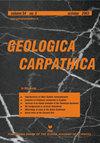The 40Ar–39Ar dating and geochemistry of the Carpathian C1 obsidians (Zemplín, Slovakia)
IF 1.5
4区 地球科学
Q4 GEOSCIENCES, MULTIDISCIPLINARY
引用次数: 1
Abstract
In situ 40Ar–39Ar UV laser ablation dating of the Carpathian C1 obsidians from the Slovakian part of the Zemplín – Tokaj area yielded new 40Ar–39Ar obsidian glass ages that fall in a narrow time interval of 12.07 ± 0.37 to 11.44 ± 0.39 Ma. This indicate that most of the Zemplín obsidian findings come from one short-time monogenic volcano, forming part of a long-lasting volcanism over the 15–10 Ma period. Chemical compositions of the Carpathian C1 obsidians clearly indicate common similarities between all examined localities (Brehov, Cejkov, Hraň, and Viničky). Geochemically, these obsidians belong to the silica-rich, peraluminous, high-potassium, calc-alkaline rhyolite series volcanic rocks of ferroan character. They were derived by multi-stage magmatic processes, from mixed mantle and crustal sources, and generated during subduction in a volcanic arc tectonic setting. The primary basaltic magma formed from the melting of the lower crustal source at the mantle/crust boundary. Subsequent formation of melt reservoirs in the middle and upper crust, accompanied by secondary melting of the surrounding rocks with continual addition of ascending melt, and repeated processes of assimilation and fractionation produced rhyolitic rocks with obsidians in the Zemplínske vrchy Mts.喀尔巴阡C1黑云母的40Ar–39Ar定年和地球化学(斯洛伐克泽姆普林)
对Zemplín - Tokaj地区斯洛伐克部分的喀尔巴阡C1黑曜岩进行了原位40Ar-39Ar激光烧蚀测年,得到了新的40Ar-39Ar黑曜岩玻璃年龄,其时间间隔很窄,为12.07±0.37 ~ 11.44±0.39 Ma。这表明Zemplín的大部分黑曜石发现来自于一个短时间的单源火山,形成了一个15-10 Ma时期的长期火山作用的一部分。喀尔巴阡C1级黑曜石的化学成分清楚地表明,在所有被检测的地点(Brehov、Cejkov、hrazov和vini ky)之间存在共同的相似性。地球化学特征表明,这些黑曜岩属于富硅、过铝、高钾、钙碱性流纹岩系列火山岩,具有铁质特征。它们是由多期岩浆作用形成的,是地幔和地壳混合源,形成于火山弧构造背景下的俯冲过程。原生玄武岩岩浆是由下地壳源在地幔/地壳边界处熔融形成的。随着中上部地壳熔体储层的形成,伴随着围岩的二次熔融和上升熔体的不断加入,以及同化和分馏的反复过程,在Zemplínske vrchy Mts中形成了含黑曜岩的流纹岩。
本文章由计算机程序翻译,如有差异,请以英文原文为准。
求助全文
约1分钟内获得全文
求助全文
来源期刊

Geologica Carpathica
地学-地球科学综合
CiteScore
2.40
自引率
23.10%
发文量
26
审稿时长
>12 weeks
期刊介绍:
GEOLOGICA CARPATHICA covers a wide spectrum of geological disciplines including geodynamics, tectonics and structural geology, volcanology, stratigraphy, geochronology and isotopic geology, karstology, geochemistry, mineralogy, petrology, lithology and sedimentology, paleogeography, paleoecology, paleobiology and paleontology, paleomagnetism, magnetostratigraphy and other branches of applied geophysics, economic and environmental geology, experimental and theoretical geoscientific studies. Geologica Carpathica , with its 60 year old tradition, presents high-quality research papers devoted to all aspects not only of the Alpine-Carpathian-Balkanian geoscience but also with adjacent regions originated from the Mediterranean Tethys and its continental foreland. Geologica Carpathica is an Official Journal of the Carpathian-Balkan Geological Association.
 求助内容:
求助内容: 应助结果提醒方式:
应助结果提醒方式:


